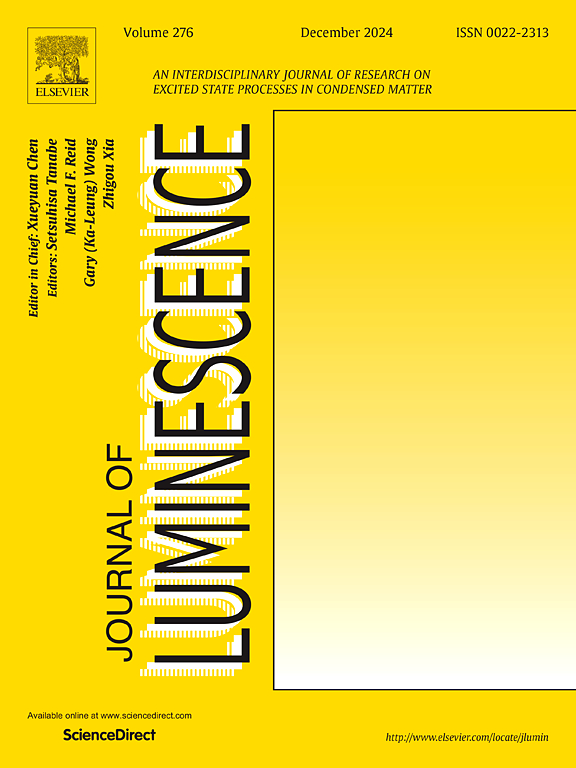Efficient management of excitons in near-infrared organic light-emitting diodes employing interlayer sensitization strategy
IF 3.3
3区 物理与天体物理
Q2 OPTICS
引用次数: 0
Abstract
Near-infrared (NIR) organic light-emitting diodes (OLEDs) have garnered significant attention owing to their promising applications in military, medical, and agricultural fields. However, the intrinsic characteristics of narrow energy gap and planar molecular structure of NIR organic materials result in low electroluminescence (EL) efficiency in OLEDs. Achieving both high efficiency and long-wavelength emission in NIR OLEDs remains a significant challenge. In this study, an interlayer sensitization strategy was employed to manage excitons and achieve highly efficient NIR-OLEDs with an emission peak wavelength exceeding 700 nm. Significantly, DMAC-DPS:TTPA was utilized as the sensitizing layer (SEL), while PPF:APDC-DTPA served as the emitting layer (EML). The separation of the EML and the SEL could effectively suppress direct carrier recombination in APDC-DTPA molecules, ensuring that the NIR emission primarily originates from exciton energy transfer from the sensitizer. Additionally, a spacer layer was incorporated to modulate exciton concentration within the NIR emitter and mitigate exciton quenching. By optimizing the doping concentration of TTPA sensitizer, highly efficient NIR OLEDs were achieved. The maximum external quantum efficiency (EQE) reached 6.61 %, with a NIR emission peak at 720 nm. These results provide a promising route to develop high efficiency NIR OLEDs for practical applications.
采用层间敏化策略的近红外有机发光二极管激子的有效管理
近红外(NIR)有机发光二极管(oled)因其在军事、医疗和农业领域的应用前景而受到广泛关注。然而,近红外有机材料的窄能隙和平面分子结构的固有特性导致了oled的电致发光效率较低。在近红外oled中实现高效率和长波发射仍然是一个重大挑战。在这项研究中,采用层间敏化策略来管理激子,并获得了发射峰值波长超过700 nm的高效nir - oled。值得注意的是,DMAC-DPS:TTPA作为敏化层(SEL), PPF:APDC-DTPA作为发射层(EML)。EML和SEL的分离可以有效抑制APDC-DTPA分子中载流子的直接重组,确保近红外发射主要来自敏化剂的激子能量转移。此外,还加入了间隔层来调节近红外发射器内的激子浓度并减轻激子猝灭。通过优化TTPA敏化剂的掺杂浓度,获得了高效的近红外oled。最大外量子效率(EQE)达到6.61%,近红外发射峰位于720 nm处。这些结果为开发具有实际应用价值的高效近红外oled提供了一条有希望的途径。
本文章由计算机程序翻译,如有差异,请以英文原文为准。
求助全文
约1分钟内获得全文
求助全文
来源期刊

Journal of Luminescence
物理-光学
CiteScore
6.70
自引率
13.90%
发文量
850
审稿时长
3.8 months
期刊介绍:
The purpose of the Journal of Luminescence is to provide a means of communication between scientists in different disciplines who share a common interest in the electronic excited states of molecular, ionic and covalent systems, whether crystalline, amorphous, or liquid.
We invite original papers and reviews on such subjects as: exciton and polariton dynamics, dynamics of localized excited states, energy and charge transport in ordered and disordered systems, radiative and non-radiative recombination, relaxation processes, vibronic interactions in electronic excited states, photochemistry in condensed systems, excited state resonance, double resonance, spin dynamics, selective excitation spectroscopy, hole burning, coherent processes in excited states, (e.g. coherent optical transients, photon echoes, transient gratings), multiphoton processes, optical bistability, photochromism, and new techniques for the study of excited states. This list is not intended to be exhaustive. Papers in the traditional areas of optical spectroscopy (absorption, MCD, luminescence, Raman scattering) are welcome. Papers on applications (phosphors, scintillators, electro- and cathodo-luminescence, radiography, bioimaging, solar energy, energy conversion, etc.) are also welcome if they present results of scientific, rather than only technological interest. However, papers containing purely theoretical results, not related to phenomena in the excited states, as well as papers using luminescence spectroscopy to perform routine analytical chemistry or biochemistry procedures, are outside the scope of the journal. Some exceptions will be possible at the discretion of the editors.
 求助内容:
求助内容: 应助结果提醒方式:
应助结果提醒方式:


